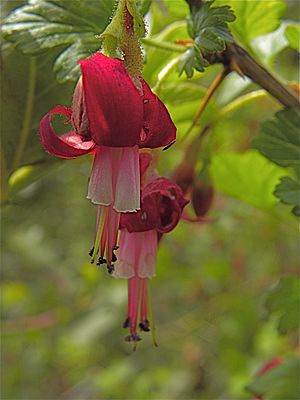Gummy gooseberry facts for kids
Quick facts for kids Gummy gooseberry |
|
|---|---|
 |
|
| Scientific classification | |
| Genus: |
Ribes
|
| Species: |
lobbii
|
| Synonyms | |
|
|
The Gummy Gooseberry (also known as the fuchsia-flowered gooseberry or pioneer gooseberry) is a type of shrub that loses its leaves in winter. It grows on the western coast of North America and needs sunlight to thrive. This plant was first described in 1876 by a scientist named Asa Gray. Its scientific name, Ribes lobbii, honors an English plant collector named William Lobb.
Contents
Discovering the Gummy Gooseberry Plant
The gummy gooseberry is a loose, bushy shrub. It usually grows about half a meter to one meter (20–40 inches) tall. Its stems spread out and have fine hairs. They typically have three thin spines at each node, which are about 7–12 mm long. The bark starts out brown and later turns a deep grayish-red color.
Leaves of the Gummy Gooseberry
The leaves of the gummy gooseberry grow on smooth stalks. Each leaf is about 1.3–2.6 cm long and 1.5–2.5 cm wide. They grow in an alternating pattern along the stem. The leaves are shaped like an oval and are slightly heart-shaped at their base. They have 3–5 rounded sections and are deeply toothed.
The top surface of the leaves feels sticky and is mostly smooth. The bottom surface has some soft hairs and small glands.
Flowers of the Gummy Gooseberry
Gummy gooseberry plants grow their flowers in early summer. The flowers usually appear in groups of one or two. They hang downwards on stalks that are shorter than the leaves. Each flower stalk is about 1.5–2 mm long and is covered in bristles and glands.
The petals are white or light pink, about 4–6 mm long, and shaped like a wide fan. They curl back towards the flower stem. The red, hairy outer parts of the flower (called calyces) are long and narrow, coming to a point. The parts that hold pollen (anthers) stick out past the petals.
Fruits of the Gummy Gooseberry
The fruits of the gummy gooseberry are round or oval-shaped berries. They are about 12–15 mm long. These berries are reddish-brown and have rough bristles and glands on them. They are safe to eat.
Where Gummy Gooseberries Grow
The gummy gooseberry prefers to grow in certain places. You can often find it near moist or dry streambanks, on rocky areas, and in open woodlands and forests. It grows in both lowlands and mountainous regions.
This plant is more common in the drier, Pacific parts of its range. It thrives in cool, mild climates that are either near the coast or slightly inland. It likes soils that are very dry to moderately dry and have a medium amount of nitrogen. You might see it scattered in areas where forests are just starting to grow back or in open Douglas-fir forests.
Gummy Gooseberry Locations
Gummy gooseberries are found in different spots across the Pacific Northwest region of the United States and British Columbia in Canada. They prefer forests and meadows in the lower parts of mountains (foothills) and higher up in the subalpine zones.
In British Columbia, Canada, you can often find them on the Gulf Islands and Vancouver Island, especially in the southern half.
In the state of Washington, they are found in several counties, including Wahkiakum, Skamania, Klickitat, Kittitas, Chelan, Pierce, Thurston, and Clallam.
In Oregon, they have been seen in coastal counties like Curry, Douglas, and Lane. They also grow in nearby counties such as Josephine, Jackson, Klamath, Benton, Linn, Jefferson, Marion, Wasco, Yamhill, Hood River, Multnomah, and Columbia.
In California, the gummy gooseberry is native to the northern coastal coniferous and red fir forests. This includes counties like Del Norte, Humboldt, and Mendocino. Further inland, they are found in Siskiyou, Trinity, Shasta, and Glenn counties. A few have also been found in Lake, Colusa, and Modoc counties.
See also
 In Spanish: Ribes lobbii para niños
In Spanish: Ribes lobbii para niños

